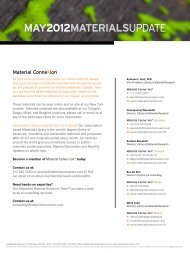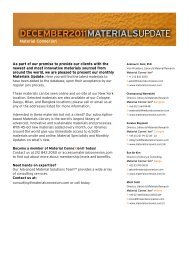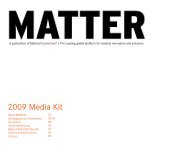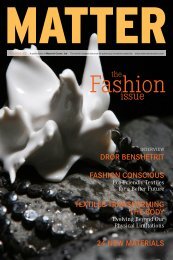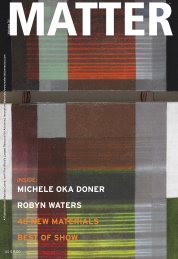48 new materials - Material ConneXion
48 new materials - Material ConneXion
48 new materials - Material ConneXion
Create successful ePaper yourself
Turn your PDF publications into a flip-book with our unique Google optimized e-Paper software.
Photo: © Textronics<br />
Photo: © Textile Testing Innovations, LLC<br />
Conducting Polymer<br />
Eeonyx debuted EeonTex, a conductive polymer<br />
(polypyrrole, PPY) coating applied to practically<br />
any textile, from Kevlar to Lycra. The coating<br />
has excellent adhesion, long term stability<br />
(confirmed with aging tests), and is insoluble in<br />
water, acids, and solvents. Applications for this<br />
product are wide reaching, from uniformly heating<br />
resistive heaters to surgical gowns (where<br />
electrostatic dissipation is important to prevent<br />
electromagnetic interference) to radar-shielding<br />
curtains and dynamic pressure sensors for custom<br />
shoe design.<br />
Etched Circuit<br />
Sauquoit Industries, LLC proudly demonstrated<br />
a working populated circuit with a functional<br />
buzzer and LED. The innovation? The circuit was<br />
etched onto fabric (the company markets this<br />
advance as CircuiteX). In a nutshell, here’s how<br />
it is made: a stencil is placed over a textile that<br />
contains silver-metallized fibers; only the noncircuit<br />
regions are etched. The result maintains<br />
the original hand of the textile, allowing it to be<br />
folded and draped.<br />
The technology conforms to existing printed<br />
circuit board manufacturing, and the final product<br />
is more flexible and cost effective than the<br />
currently available flexible circuits composed of<br />
Mylar® polyester film and copper foil.<br />
Engineers in the automotive and aerospace industries,<br />
who are always looking for ways to<br />
shave off pounds, should find CircuitexT intriguing.<br />
Sauquoit Industries is also currently partnering<br />
with companies that serve the medical<br />
and apparel industries.<br />
PCMs incorporated into a car seat<br />
NuMetrix Sports Bra<br />
Any woman who has worn a heart monitor<br />
chest strap will appreciate the comfort of the<br />
NuMetrix sports bra from Textronics, one of<br />
the first commercially available garments incorporating<br />
smart fabrics. A stretchy conductive fabric<br />
in the chest band accurately senses heart rate<br />
and a small, snap-in transmitter, removed during<br />
washing, sends data to a heart rate-monitoring<br />
watch. It can also communicate with some fitness<br />
machines with integrated monitoring devices such<br />
as treadmills and elliptical trainers. A man’s T-shirt<br />
is planned for this year.<br />
SmartShirt<br />
Sensatex presented SmartShirt, a T-shirt that<br />
knows whether you’re breathing, walking, standing,<br />
or have fallen…or are even alive (it senses<br />
heart beat as well). The soft, washable T-shirt is<br />
woven through with a conductive fiber grid composed<br />
of woven optical and metal fibers. Information<br />
is relayed wirelessly for remote analysis.<br />
Not surprisingly, the technology was originally<br />
developed by researchers at the Georgia Institute<br />
of Technology with funding from the Defense<br />
Advanced Research Projects Agency to monitor a<br />
soldier’s location and send vital signs to medics. It<br />
also has obvious relevance to first response teams<br />
and managed and infant care facilities. Sensatex<br />
will soon release a beta commercial version to collect<br />
research data. A commercial product launch<br />
is planned for late 2006.<br />
PowerPlastic<br />
PowerPlastic, currently under development by<br />
Konarka Technologies, is a low-cost, lightweight,<br />
flexible polymer photovoltaic (PV) material that<br />
promises to make solar power even greener: it is<br />
free from the toxic chemicals cadmium and gallium,<br />
unfortunately present in other PVs. Furthermore,<br />
it can be printed upon, and, compared<br />
to silicon PVs, it offers greater light sensitivity<br />
resulting in higher power density. Built-in power<br />
generation capability shouldn’t be too far off.<br />
True, the conversion efficiency is below average<br />
(7.5% compared to 12%, with some PVs as high<br />
as 20%). Hopefully further research will quickly<br />
close that gap.<br />
Even as it is, PowerPlastic opens up many <strong>new</strong><br />
product opportunities: camouflage military uniforms<br />
or tent <strong>materials</strong>, backpacks and handbags<br />
with logos, awnings, shades or glass films for windows,<br />
cell phones with built-in power generation,<br />
and PVs for roofs with the appearance of shingles.<br />
This is an exciting green development.<br />
MATERIAL PROFILE<br />
25




